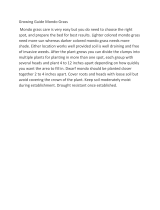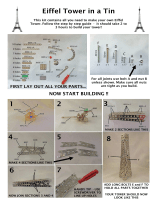Page is loading ...

2
Venice
Built on over 100 islands in a marshy lagoon at the edge
of the Adriatic Sea, Venice has a skyline that rises from
the water to create a unique architectural experience.
There are no roadways or cars in the historic city; instead
177 canals crossed by over 400 bridges give access to
innumerable narrow, mazelike alleys and squares.
While the origin of the city dates back over 1500 years,
the golden age of Venice occurred during the late
Middle Ages and Renaissance periods when it became
one of the most powerful republics in the eastern
Mediterranean.
Today the city is facing major challenges including
gradual subsidence, flooding, and problems caused
by its popularity as a tourist destination. More than
60,000 people visit Venice each day—more than the
population of the city itself—putting pressure on the
city to accommodate these guests while maintaining its
unique nature and identity.

4
The Rialto Bridge (Ponte di Rialto) spans the Grand Canal
at the heart of the historic city. Built between 1588 and
1591, it replaced earlier wooden bridges that had linked
the districts of San Marco and San Polo since the 12th
century.
When the last wooden bridge collapsed in 1524, several
projects were considered before the city authorities
requested plans for a stone bridge in 1551. The architect
Antonio da Ponte competed with illustrious competitors
such as Michelangelo and Palladio before winning the
contract.
His single span design with a 24 ft. (7.5 m) arch included
three walkways: two along the outer edges and a wider
central walkway between two rows of small shops. The
entire structure was built on some 12,000 wooden pilings
that still support the bridge over 400 years later.
Rialto Bridge
[ “To build a city where it is
impossible to build a
city is madness in itself,
but to build there one
of the most elegant and
grandest of cities is the
madness of genius.” ]
Alexander Herzen

5
Rialto Bridge

6
Bridge of Sighs (Ponte dei Sospiri) is an enclosed bridge
constructed in white limestone that passes over the
Rio di Palazzo, connecting the old city prison to the
interrogation rooms in the Doge’s Palace. Designed by
Antonio Contino, the nephew of Antonio da Ponte who
created the Rialto Bridge, the bridge was completed in
1602.
The bridge’s romantic name is thought to refer to the
sighs of convicts as they saw their last view of Venice
before being taken to their prison cells. In reality, very
little of the city could be seen through the stone grills
covering the windows and the majority of prisoners at
that time were small-time criminals.
Bridge of Sighs
[ “I stood in Venice, on the
Bridge of Sighs, A palace
and a prison on each hand.” ]
LordByron
BridgeofSighs

7
St. Mark’s Campanile
As one of the tallest structures in the city, St. Mark’s
Campanile (Campanile di San Marco) is one of
Venice’s most recognizable symbols. From here the
visitor has an incredible view of the city and lagoon
as well as the Italian Alps in the distance.
The 323 ft. (98.6 m) bell tower stands alone in the
corner of St. Mark’s Square, near the front entrance
to the basilica. The brick structure is 39 ft. (12 m)
wide on each side and 160 ft. (50 m) tall, upon which
sits a belfry housing five bells. A spire caps the tower
with a golden weather vane on top.
Though the design of the Campanile is from the
16th century, the tower itself was completely rebuilt
in 1912 after the original one collapsed in 1902. The
inauguration of the new tower occurred exactly 1000
years after the foundation of the original tower was
laid.
StMark’sCampanile

8
St. Mark’s Basilica
St. Mark’s Basilica (Basilica di San Marco) is the most
famous church in Venice and the best-known example
of the city’s unique Italo-Byzantine architecture.
Built to house the relics of Mark the Evangelist, little
is known about the original church buildings, but the
current structure is thought to have been constructed
between 1073 and 1093. The basilica is laid out in the
design of a Greek cross and the tallest of the five
domes reach 141 ft. (43 m) in height.
While the layout of the church has remained constant
over the centuries, the decoration on the inside and
outside of the church has changed greatly. Venice’s
involvement in crusades and conquests saw mosaics,
columns, and friezes from all over the Mediterranean
added to the original opulent, golden mosaic interior.
Outside, the exterior brickwork was gradually covered
with marble cladding and carvings as Venetian vessels
returned with the spoils of war and trade.
A symbol of the wealth and power of the Venetian
Republic, St. Mark’s Basilica remains one of the city’s
most impressive landmarks today.

9StMark’sBasilica

10
St. Theodore and the Lion of Venice columns
Two granite columns stand guard at the entrance to St.
Mark’s Square (Piazza di San Marco).
On top of the western column is a statue of St. Theodore,
the first patron of the city. Here he holds a spear and his
foot rests upon a crocodile—representing the dragon he
was said to have slain. On the eastern column stands the
winged Lion of Venice, the symbol of the second patron
of the city, St. Mark.
Both columns are believed to have been erected in about
1268 and it is believed that the city executed convicted
criminals between the two columns in days gone by. To
this day, superstitious Venetians avoid walking between
this pair of columns.
[ “There is a glorious city in
the sea. The sea is in the
broad, the narrow streets,
Ebbing and flowing... ” ]
SamuelRogers

11
StTheodoreandtheLionofVenicecolumns

33
1x
15
As many of the small islands in the lagoon were
spongy marshland, the majority of buildings sit
upon a foundation of wooden piles.
A causa della natura paludosa di molte delle
piccole isole della laguna, la maggior parte degli
edifici fu costruita su pali di legno.
© Kite_rin

41
1x 1x
2x2x
23
During the Acqua Alta (high water) tides
can rise up to 6 ft. (2 m) and often flood St.
Mark’s Square.
Durante l’acqua alta, la marea può
raggiungere i 2 m e spesso allaga
Piazza San Marco.
© BlueMoonStore

45
6x 6x 1x
1x2x
27
Venice is slowly sinking at the rate of
about 0.04 inches (1-2 mm) every year.
Venezia sta sprofondando
lentamente, a una velocità di
circa 1-2 mm all’anno.
© pio3

53
2x
35
The Grand Canal is the region’s largest canal.
Possessing a unique S-shape,
it splits the city in half.
Il Canal Grande è il canale più grande
dell’intera regione. A forma di S, divide
la città in due parti distinte.
© TTstudio

63
43
Venice has over 450 palaces and major buildings
built in a mixture of styles: Gothic, Byzantine,
Baroque etc.
Venezia conta oltre 450 palazzi e grandi
edifici in diversi stili: gotico, bizantino,
barocco, ecc.
© Iakov Kalinin

81
49
Venice has over 170 bell towers.
St Mark’s Campanile is the
tallest one in the city.
Venezia conta oltre 170
campanili. Il Campanile di San
Marco è il più alto della città.
© KKulikov

90
[ “Venice is like eating an
entire box of chocolate
liqueurs in one go.” ]
TrumanCapote
[ “Venezia è come
mangiare
un’intera scatola
di cioccolatini al liquore
in una sola volta”. ]
TrumanCapote

91
© TT Studio

92
LEGO
®
Architecture—then and now
There has always been a natural connection between the
LEGO
®
brick and the world of architecture. Fans who build
with LEGO elements instinctively develop an interest in
the form and function of the structures they create. At the
same time, many architects have discovered that LEGO
bricks are the perfect way of physically expressing their
creative ideas.
This connection was confirmed in the early 1960s with
the launch of the LEGO ‘Scale Model’ line. It matched
the spirit of the age where modern architects were
redefining how houses look and people were taking an
active interest in the design of their new homes. These
sets were designed to be different from the normal,
brightly colored LEGO boxes; they also included a book
on architecture as a source of inspiration.
Decades later, architect and LEGO fan Adam Reed
Tucker revived the idea of expressing architecture using
LEGO bricks and in partnership with the LEGO Group,
launched the LEGO Architecture line that we know today.
His first models, and the original sets in the current
LEGO Architecture series, were interpretations of famous
skyscrapers from his hometown of Chicago. Since then
LEGO Architecture has developed and evolved, first
with well-known buildings from other cities in the United
States, and now with iconic structures from Europe, the
Middle East and Asia.
The introduction of our LEGO Architecture Studio set
echoes the ambitions of the earlier LEGO ‘Scale Model’
line and widens the potential of the LEGO Architecture
series. Now you can enjoy building and learning
about specific landmark buildings, or create exciting
architectural models from your own fantasy. An inspiring
270-page book, featuring a number of renowned
architects from around the world, guides you through the
principles of architecture and encourages you in your
own creative building.

96
Celebrate the world of architecture and collect all the models
Celebrailmondodell’architetturaecollezionatuttiimodelli
21019
The Eiffel Tower
Torre Eiffel
21013
Big Ben
21024
Louvre
21006
The White House
Casa Bianca
21023
Flatiron Building
Grattacielo Flatiron

97
21020
Trevi Fountain
Fontana di Trevi
21022
Lincoln Memorial
21031
Burj Khalifa
21027
Berlin
Berlino
21028
New York City
/

